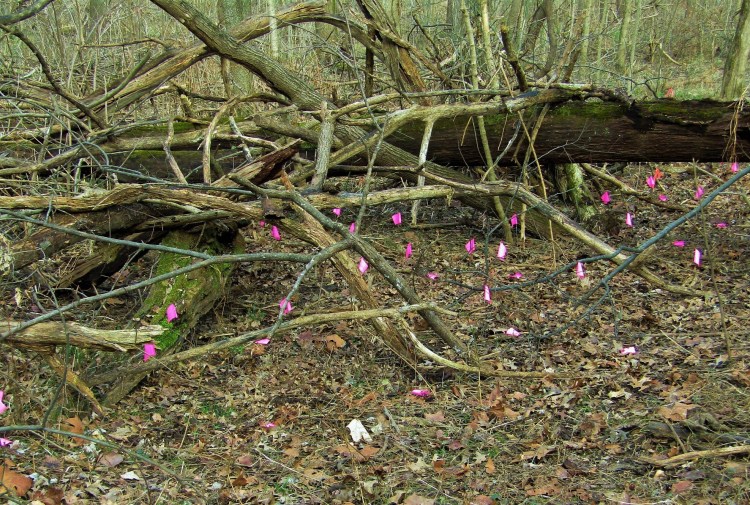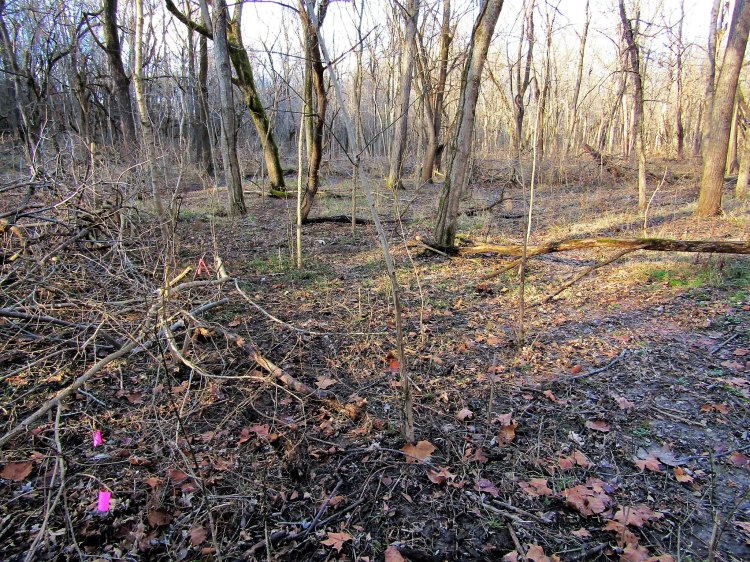
Once upon a time, the South Fork of Beargrass Creek meandered across a floodplain rich with spring ephemeral wildflowers. Though the passing millennia brought changes in climate, soils, and geology that slowly altered this flora, the rapid changes of just the past few hundred years have caused the local extinction of most of it. So when deciding what to plant and where, one can only draw on experience with similar sites that are less damaged. But sometimes it’s easy. In my mind’s eye I see another floodplain along a riverbank in southern Indiana, covered with acres of the purest cerulean blue. Virginia Bluebells, of course.

Virginia bluebells likely once grew in these lowlands too, and if so there were masses of them, since they spread easily. A perfect plant to start a wildflower restoration project with – easy to grow, not picky about soils, and delightful to the senses. I was hoping to plant them on a broader scale than what was affordable with potted plants, so I went searching online. One of my favorite native plant nurseries offers bare root wildflowers at wholesale prices; 100 + plants were only $1.50 apiece, plus $20.00 or so for shipping. With visions of bluebells dancing in my head I placed the first order.

They arrived a couple weeks ago; lots and lots of fat little black rhizomes about the size of my pinkie, with white shoots already showing which end was up. The first planting site was chosen – a low moist area near trail post #20, and I’d been busy enhancing the soil with additions of organic matter from nearby rotten stumps and bags of oak leaves from our backyard. Instructions were simply to bury the rhizomes about one inch deep, water them, and wait for spring.
On a mild winter day last week, fellow forest steward Kay Combs and I gently placed each little rhizome in its new home. A very bright pink plastic flag went beside each one, enabling us to space them about 8 – 12 inches apart. This garish intrusion in the landscape has piqued people’s curiosity, particularly since there’s nothing to see till springtime.

Having no previous experience with bare root wildflowers, I don’t know if any of them will actually be ready to bloom this spring. But if they do, their soft blue hues and mild fragrance will get the attention of any nearby bumblebee or butterfly. The funnel shaped blooms are adapted mainly for long tongued pollinators; smaller bees may want the nectar but struggle to get to it. For human visitors, it’s a flower that lights up the woods like no other, the abundant blossoms morphing from pink to rare sky blue as they open.
There was a time when when the invasive plant issues in this little forest seemed too overwhelming to imagine planting wildflowers. Like adding icing to a cake that wasn’t baked yet, it would have been pointless. This year, finally, there are places mostly free of invasive plants, but still lacking the diverse community of native plants that once thrived here. The hard lesson has been this – no matter what you do, many native plants, especially spring ephemerals, will not return on their own once they’ve been lost. Particularly in a small fragment isolated from other plant populations. The little site where the first bluebells were planted was for decades covered with a deeply embedded and spreading mat of invasive Wintercreeper, and little else. Several years of hacking, handpulling, and herbicide spraying have been necessary to return it to a condition that’s ready for planting. When the bluebells finally bloom, it will be visible proof of the hard-won progress we’ve made.


But now that the first 100 rhizomes have been planted, I’m starting to notice how many places they are not. Beyond the pink flags is an expanse of equally suitable rich moist soils, waiting for more Virginia bluebells. And this is where I do something I’ve never done before on this blog – ask you to help us buy plants. Though undoubtedly all your favorite causes have been asking for money at this season, the forest stewards would be happy with a small donation. For every 20 people who give $5.00, the forest will receive 100 more bluebells. And no need to stop at bluebells – how about Dutchman’s breeches, Jacob’s ladder, Celandine poppy…… But the best part of this deal is what you get back. No need to wonder where the money went – come April, take a walk in the woods and see.


Perhaps one day our bottomland forest will again look like this in April.
Donations for Virginia bluebells and other wildflowers can be made at louisvillenaturecenter.org by clicking the “donate” button, and specifying it’s for the forest stewards. Don’t do online donations? Put a check in the mail or just drop by with cash, we’re always happy to chat!
Added bonus – come spring I’ll lead a wildflower walk for donors only, to see this forest’s hidden pockets of recovering spring ephemerals.

Marianna metcalf
What a wonderful chance. Hope to be able to donate later in Januari, when i am around
Happy green and wildflowery newyear!
LikeLiked by 1 person
Phyllis Fitzgerald
If I dig a bunch of blooming celandine poppies in March or April from my yard, would that be too late to plant them? Phyllis Fitzgerald
LikeLiked by 1 person
oneforestfragment
Thanks for the offer! If there’s plenty of dirt with them should be fine. Better yet, dig them when leaves first emerge.
LikeLike
tonytomeo
I remember these. Did you write about them earlier? They look weirdly similar to our native species on the other side of the Continent. Ours do not last long though. they bloom very early, foliate very briefly, and then disappear for another many months. I don’t know how they survive such a long dormancy.
LikeLiked by 1 person
oneforestfragment
looked up the taxonomy of Mertensia and it’s very interesting. A circumboreal genus with diversity centered in the Rocky mtn’s. Perhaps you have M. oblongifolia, Sagebrush Bluebells? I’m guessing the secret of it’s long dormancy is the same as most of our spring ephemerals – a corm or rhizome with a lot of stored energy. M virginica of the eastern US is off on it’s own as a species, diverged a long time ago after climate and geography isolated it. Many of the same genera, and closest relatives of our eastern flora are found in Asia.
LikeLiked by 1 person
oneforestfragment
M. virginica is sometimes found in gardens since it’s easy to grow. Is your western plant occuring naturally or in cultivation?
LikeLiked by 1 person
tonytomeo
It grows wild in the forest. It seems to appreciate the removal of other plants from around it. When I burn debris on the spots where it is, it comes back rather happy through the ash before anything else does.
LikeLike
j3w3lw33d
Hummingbirds will be attracted to them as well!
LikeLiked by 1 person
oneforestfragment
I would love to see that! There are not a lot of big showy flowers in early spring so hopefully they will be popular with pollinators.
LikeLike